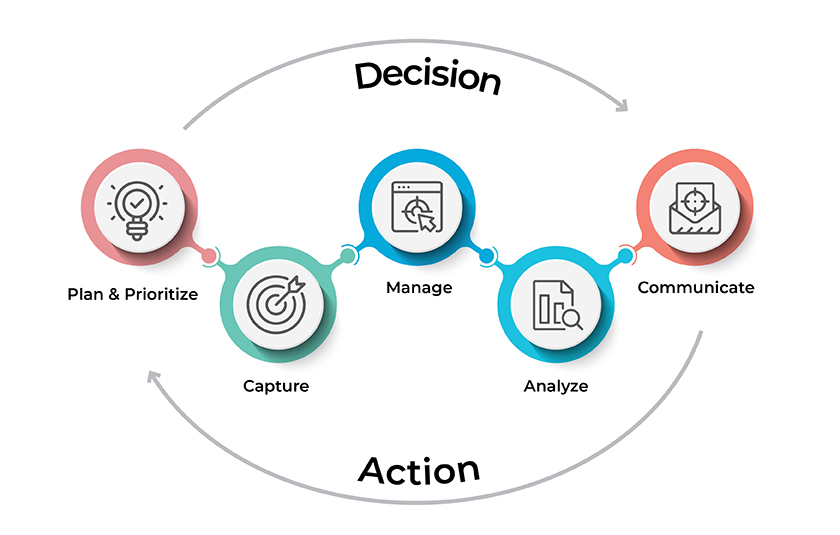All organizations gather competitive intelligence in some form or another. Although prevalent, its impact on decision-making varies. In fact, in a study by HBR, 45% of CI managers said that their insights made little difference to improve management decisions. What can CI managers and analysts do to drive greater impact from the competitive intelligence they provide? One way is to conduct it in a more structured and systematic manner. At Netscribes, we use standardized competitive intelligence processes to support our clients’ varied insight needs. Read on to give your CI efforts more clarity and direction.
Types of competitive intelligence processes
Competitive intelligence supports a wide range of applications from making investment decisions to planning product launches. Depending on the purpose it serves, different types of competitive intelligence processes are carried out. Varying on specificity and duration (they could be more or less specific and of shorter or longer duration), these include:
Ad hoc
Ad hoc processes are irregular and unpredictable, typically supporting tactical work where there’s a high demand for rapid results. These studies are conducted when there’s a need for analyzing a specific area. For example, knowing which networking events my competitors are going to participate in can help you better plan your firm’s own event calendar. If a new, disruptive trend is uncovered, an ad hoc study can help dig deeper into the trending market activity. Additionally, it can also help discover the routes favored by competitors.
Regular
Regular processes, as the name suggests, provide competitive intelligence at certain intervals on a regular basis. These processes have a predictable need for intelligence. This can include analysis of varied scopes. These can include weekly competitive reports that track new product launches, major investments, and acquisitions. Altogether, it will shape whether you can stay on top of the market. Owing to their predictable nature, intelligence operations can be standardized.
Regular and continuous processes typically support strategic decisions at various levels.
When regular processes entail in-depth analysis, they can be continuous and specific or continuous and unspecific.
Continuous and specific analysis
Here, the intelligence work is focused on defined critical areas of business. These processes are conducted with a more long-term perspective in mind. For example, continuous surveillance of defined competitors and markets with a specific focus on certain parameters like current partners, new partnership deals and their duration, stakeholder’s regions of interest, CI analysis of a company’s annual reports and announcements, etc. The competitive intelligence process will identify the target areas. It will further provide a comprehensive analysis and recommendations based on these specifications. This is undertaken with the strategic goal of anticipating market opportunities.
Continuous and unspecific analysis
This analysis sifts through larger, unspecified areas of focus. While tackling open-ended requirements by the management, firms often require a broad intelligence process. This is to uncover unexpected contingencies that can lead to threats or opportunities for the business. This type of CI aims to serve as an Early Warning System (EWS). Its purpose is to enable organizations to stay informed and proactive in both short and long-term circumstances. This analysis keeps the firm acquainted with larger market trends and opportunities. By doing so, they can capitalize on and be wary of disruptive entrants. For instance, a large market player looking to enter a new market will venture into uncharted waters. Consequently, he will require this form of broad intelligence to understand and navigate uncertain market forces.
A real-life example
Illustrating a case in point, a leading ICT company sought Netscribes’ support to identify key, strategic focus areas for business growth that would help them retain a competitive edge in the global IT infrastructure market. To understand the scope of innovation in this vast area of focus, it was necessary for the client to acquire a deeper understanding of the global IT market. Given the broad, unspecified nature of the ask, Netscribes made sure to meticulously choose the relevant subject domains and then proceeded to undertake an independent, in-depth competitive intelligence analysis targeting the following key focus areas:
- Determining the market size particularly for North America, growth rate, and growth rate forecasts for the next 3-5 years
- Key market drivers and major trends/disruptions in the industry
- Solutions and investments implemented by clients
- Buyer-side requirements
- Ongoing deals
- Vertical-specific solutions offered globally by competitors
- Variations of thought-leadership content available across multiple channels
The comprehensive competitive intelligence report captured information points that eventually enabled the client to identify possible gaps in their operations and effectively address problem points. The client not only gained a holistic view of the industry but was also able to channelize their focus on specific areas requiring the company’s urgent attention.
Read the case study here: Competitive Intelligence – Global IT Infrastructure Market
The PCMAC model for competitive intelligence
One of the most common models for conducting competitive intelligence in a systematic way is the PCMAC – Plan and Prioritise, Capture, Manage, Analyse and Communicate. Here’s what it means.

Plan & prioritize:
The most important step before conducting competitive intelligence is to understand the purpose of doing it. This means gaining clarity on the following before beginning with the competitive intelligence process:
- Why is this intelligence needed?
- What questions are we trying to answer through this intelligence?
- Which decisions will this intelligence support?
The answers to these questions will lay down the framework that enables you to formulate a suitable plan of action. It lets you identify key intelligence topics, questions, and sources of information and accordingly allocate the appropriate resources for the task.
Capture
Collect and collate data from multiple reliable sources. This includes structured data gathered through primary sources, such as store visits and interviews with customers and employees of your competition, as well as unstructured data gathered from competitor websites, annual reports, social media, patent databases, job postings, among many others.
Manage
The next step is to treat your data to make it analysis-ready. This step generally includes validating, formatting, and standardizing the collected information so that CI analysts can draw accurate conclusions and drive proactive action.
Analyze
This is where the magic happens. It is at this stage where analysts look at competitive data cohesively to inform tactical and strategic decisions. It is important that the analyst has a complete picture based on both external and internal information sources. This is only possible through a clear definition of the purpose of the study.
Communicate
This is the last and the most crucial step in the competitive intelligence process. Depending on the type and purpose, organizations may choose different formats to receive intelligence. For example, continuous CI processes typically use regularly updated dashboards, web-based platforms, and newsletters, besides the good old PowerPoint deck.
The PCMAC model is well suited for all types of competitive intelligence operations. Today, several competitive intelligence tools and platforms are available to streamline this process in the best way. An efficient competitive intelligence process goes beyond mere data capturing. It should offer proactive recommendations and predictive insights in order to create a competitive advantage.
Gaining timely, relevant, and comprehensive competitive intelligence can consequently help your company increase market share and gain competitive “win rates”. Netscribes’ competitive intelligence solution provides detailed competitor and industry insights that can be further combined with your own unique sets of data to create differentiated strategies and actions. To know more, contact us.






